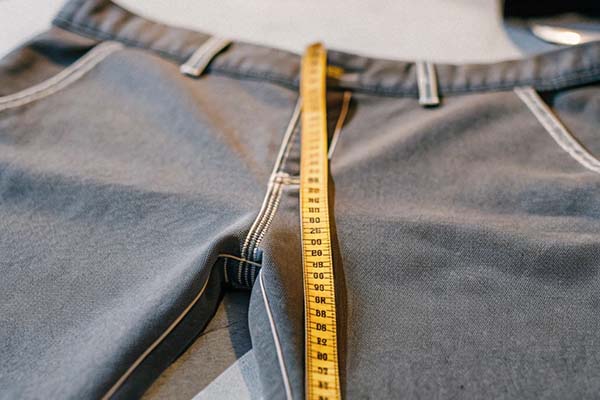Getting the right inseam measurement is crucial for ensuring pants fit comfortably and look great. Whether you’re buying off-the-rack or tailoring a custom pair, understanding how to measure your pants’ inseam1 accurately can save you time and money.
To measure a pants inseam at home2, use a measuring tape to determine the length from the crotch seam to the bottom hem of the pant leg. For best results, measure while wearing well-fitting pants or have someone assist you for precision.
This guide will explain the step-by-step process for measuring a pants inseam, discuss why it matters, and provide tips for ensuring the perfect fit.

What Is the Inseam, and Why Is It Important?
The inseam is the measurement along the inside leg of a pair of pants, running from the crotch to the bottom hem. It plays a key role in determining the length and overall fit of the pants.
1. Ensures Proper Length
- Avoids pants being too long and dragging on the ground.
- Prevents pants from being too short, which can look awkward.
2. Provides Comfort
- A correctly measured inseam ensures the pants don’t bunch up or restrict movement.
- Essential for activewear or tailored pants that need precision for functionality.
3. Determines Style
- Different styles of pants, such as cropped or full-length, require specific inseam measurements.
Step-by-Step Guide to Measuring a Pants Inseam
Step 1: Gather Your Tools
- Measuring Tape: A soft, flexible tape works best.
- Flat Surface: Use a clean, flat surface like a table or floor.
- Well-Fitting Pants (Optional): Select a pair of pants that fit you well as a reference.
Step 2: Lay the Pants Flat
- Place the pants on a flat surface with the legs fully extended.
- Smooth out any wrinkles to ensure accurate measurement.
- Align the seams for consistency.
Step 3: Measure the Inseam
- Start at the crotch seam where the pant legs meet.
- Run the measuring tape down the inside seam to the bottom of the pant leg.
- Record the length in inches or centimeters.

Step 4: Double-Check Your Measurement
- Repeat the process to ensure accuracy.
- If possible, have someone assist you for better precision.
Measuring the Inseam While Wearing Pants
If you don’t have a reference pair of pants, you can measure your inseam while wearing pants.
How to Measure:
- Stand straight against a wall with your legs slightly apart.
- Use a measuring tape to measure from the crotch seam down to the desired pant length.
- Ask a friend or use a mirror to ensure the tape stays straight.
Inseam Variations for Different Pant Styles
The inseam length varies based on the style and purpose of the pants. Here are some common variations:
1. Full-Length Pants
- Measure to the point where the pants just touch the top of your shoes.
Best For: Formal trousers, jeans, and casual pants.
2. Cropped Pants
- Measure to a few inches above the ankle for a modern, tailored look.
Best For: Trendy styles and warm-weather clothing.
3. Activewear
- Ensure the inseam allows for full range of motion and doesn’t restrict movement.
Best For: Joggers, leggings, and gym pants.
4. Shorts
- Measure to your preferred length, such as mid-thigh or just above the knee.
Best For: Casual and athletic shorts.
Common Inseam Lengths and Sizing
Inseam lengths are often standardized for different sizes. Below is a general guide:
| Size | Inseam Length | Ideal For |
|---|---|---|
| Short | 28–30 inches | Petite or shorter builds. |
| Regular | 31–34 inches | Average height. |
| Tall | 35+ inches | Taller individuals. |

Tips for Getting the Perfect Inseam Measurement
1. Consider Your Shoe Choice
- Measure inseams while wearing the type of shoes you plan to pair with the pants, such as heels, sneakers, or boots.
2. Account for Shrinkage
- Why pants shrink after washing3 is a concern for materials like cotton, so add half an inch to the inseam if necessary.
3. Tailoring Options
- Choose a slightly longer inseam if you plan to have the pants hemmed for a precise fit.
4. Match to Your Style
- Choose the right pant break4 for your overall look:
- No Break: Pants just skim the shoes for a modern look.
- Half Break: A slight fold at the bottom for a classic style.
- Full Break: A pronounced fold for traditional or formal pants.
Why Professional Tailors Focus on the Inseam
Professional tailors measure inseams with precision to ensure the best fit for each client. Here’s why they emphasize it:
1. Customization
- Tailors adjust inseams based on body proportions, ensuring a personalized fit.
2. Enhancing Silhouette
- Proper inseam length complements the overall look of the pants, enhancing the wearer’s silhouette.
3. Improving Comfort
- A tailored inseam prevents pants from feeling too tight or restrictive.
Common Mistakes When Measuring the Inseam
1. Measuring on Uneven Surfaces
- An uneven surface can distort measurements.
2. Not Accounting for Posture
- Standing unnaturally while measuring can result in inaccurate inseams.
3. Forgetting Fabric Type
- Stretchy materials may require a slightly shorter measurement than non-stretch fabrics.
Inseam Measurement for Online Shopping
Many online retailers list inseam lengths for their pants, making it crucial to know your exact measurements.
How to Use Your Inseam:
- Compare your inseam measurement to the product sizing chart.
- Check customer reviews for insights on whether the pants run long or short.
Conclusion
Measuring the inseam is a straightforward yet essential step for finding pants that fit comfortably and look great. By following this guide, you can ensure accuracy whether shopping for off-the-rack styles, tailoring custom garments, or creating your own clothing. Recommended inseam lengths for pants5 can vary, but with the right measurement technique, you’ll achieve a polished and comfortable fit every time.













